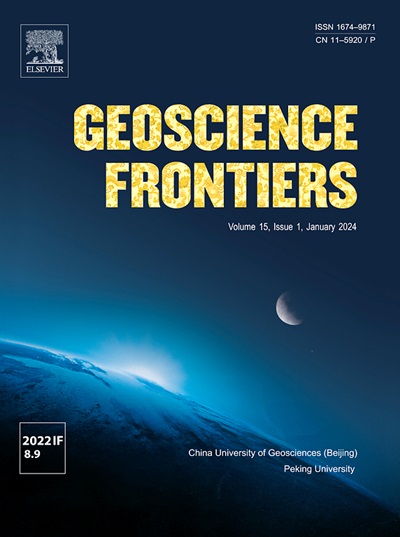CAUM: A software for calculating and assessing chemical ages of uranium minerals
IF 8.9
1区 地球科学
Q1 GEOSCIENCES, MULTIDISCIPLINARY
引用次数: 0
Abstract
It has been shown that the age of minerals in which U ± Th are a major (e.g., uraninite, pitchblende and thorite) or minor (e.g., monazite, xenotime) component can be calculated from the concentrations of U ± Th and Pb rather than their isotopes, and such ages are referred to as chemical ages. Although equations for calculating the chemical ages have been well established and various computation programs have been reported, there is a lack of software that can not only calculate the chemical ages of individual analytical points but also provide an evaluation of the errors of individual ages as well as the whole dataset. In this paper, we develop a software for calculating and assessing the chemical ages of uranium minerals (CAUM), an open-source Python-based program with a friendly Graphical User Interface (GUI). Electron probe microanalysis (EPMA) data of uranium minerals are first imported from Excel files and used to calculate the chemical ages and associated errors of individual analytical points. The age data are then visualized to aid evaluating if the dataset comprises one or multiple populations and whether or not there are meaningful correlations between the chemical ages and impurities. Actions can then be taken to evaluate the errors within individual populations and the significance of the correlations. The use of the software is demonstrated with examples from published data.

计算和评估铀矿物化学年龄的软件
以U±Th为主要成分(如铀矿、沥青铀矿和钍矿)或次要成分(如独居石、xenotime)的矿物的年龄可以通过U±Th和Pb的浓度而不是它们的同位素来计算,这种年龄被称为化学年龄。虽然计算化学年龄的公式已经建立得很好,各种计算程序也已被报道,但缺乏既能计算单个分析点的化学年龄,又能提供单个年龄误差评估以及整个数据集的软件。在本文中,我们开发了一个计算和评估铀矿物化学年龄的软件(CAUM),一个基于python的开源程序,具有友好的图形用户界面(GUI)。首先从Excel文件中导入铀矿物的电子探针微量分析(EPMA)数据,用于计算单个分析点的化学年龄和相关误差。然后将年龄数据可视化,以帮助评估数据集是否包含一个或多个种群,以及化学年龄和杂质之间是否存在有意义的相关性。然后可以采取行动来评估个体群体中的误差和相关性的重要性。并以已发表的数据为例说明了该软件的使用。
本文章由计算机程序翻译,如有差异,请以英文原文为准。
求助全文
约1分钟内获得全文
求助全文
来源期刊

Geoscience frontiers
Earth and Planetary Sciences-General Earth and Planetary Sciences
CiteScore
17.80
自引率
3.40%
发文量
147
审稿时长
35 days
期刊介绍:
Geoscience Frontiers (GSF) is the Journal of China University of Geosciences (Beijing) and Peking University. It publishes peer-reviewed research articles and reviews in interdisciplinary fields of Earth and Planetary Sciences. GSF covers various research areas including petrology and geochemistry, lithospheric architecture and mantle dynamics, global tectonics, economic geology and fuel exploration, geophysics, stratigraphy and paleontology, environmental and engineering geology, astrogeology, and the nexus of resources-energy-emissions-climate under Sustainable Development Goals. The journal aims to bridge innovative, provocative, and challenging concepts and models in these fields, providing insights on correlations and evolution.
 求助内容:
求助内容: 应助结果提醒方式:
应助结果提醒方式:


